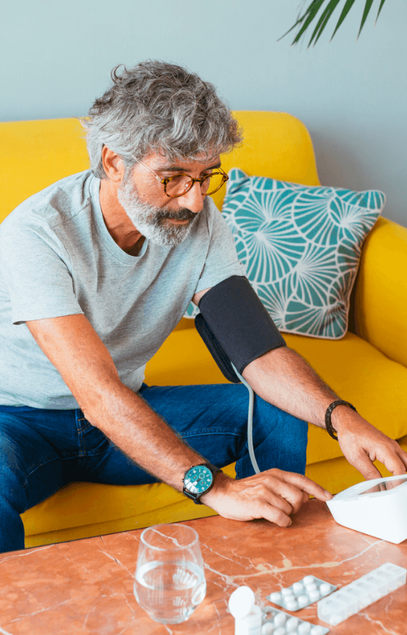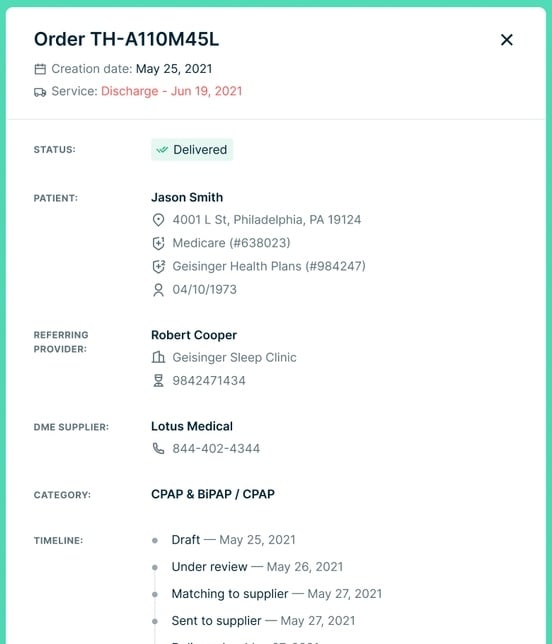Transforming Post-Acute Care with DME Technology
For most patients, recovery is a journey, and often a longer one than they’d like. Most would rather take that journey at home, where they’re comfortable and closer to loved ones. In fact, 77% of adults over 50 want to stay in their homes as long as possible.1
Home-based care at scale presents logistical challenges. With the right tech and equipment, they can be overcome.
Enter a new crop of tech solutions connecting payors, the healthcare system, patients, and caregivers. The vision? A holistic approach to post-acute care that bridges the gap between home and hospital.
1 AARP: 2021 Home and Community Preferences Survey

“I was one click away from buying a hospital bed online. I sent a message to my Care Manager who immediately directed me to Tomorrow Health.
5 minutes later, she had saved me $2,000 and a hospital bed was delivered two days later.”
The demand for home-based care is higher than ever
Patients preferring the familiarity, comfort, and independence of home isn’t new. So what’s changed? Technology — or at least the promise of it.
Over the last two decades, there’s been a steady shift of post-acute care from the hospital to the home. As of 2019, 40% more Medicaid recipients were receiving in-home health services compared to 2001.2 The COVID-19 pandemic only accelerated this trend. In 2022, spending on home health services increased by 6%, a large leap from just 0.3% growth the year before.3
With recently developed software tools, the healthcare industry is getting closer to consistently delivering post-acute care outside a hospital setting. But the current system hasn’t hit the mark just yet.
Traditional home-based care prioritizes the paperwork over the patient, leading to delays
The promise of in-home, post-acute care is a compelling one. But right now, it's typically not delivering on that vision. Today’s home-care model isn’t seamless and transparent enough to offer a good patient experience.
The right tech and tools are emerging — but have yet to be implemented at scale. That creates poor communication between patients, caregivers, and providers, holding back quality of care.
- Patients and caregivers face an overwhelming amount of administrative work, like paperwork and compliance requirements, as they set up the home care environment
- Language barriers between patients or caregivers and medical staff can compound communications issues further
- The current process of durable medical equipment (DME) ordering offers zero visibility into the quality or reliability of devices available, let alone when they might arrive.
.jpg)

The result? Dissatisfied patients and millions of dollars lost for payors. Payors typically spend as much as $52 per member per month on home-based care without adequate control of referral patterns and utilization.
From the member side, DME delays have a real human cost. Patients are waiting weeks or months to get the equipment they need to start home-based care, negatively affecting recovery and outcomes.
Instead, patients and caregivers deserve a modern, e-commerce-like experience:
-
Intuitive, integrated DME ordering
- Orders tracked and shipped to the patient’s door
- Transparency in vetting devices and suppliers
In today’s buying culture, people expect this level of visibility and convenience when ordering any product, let alone life-supporting medical equipment.
Offering home-based care at scale means connecting everyone in the ecosystem
It’s time to transition from today's manual, disjointed home care system towards a new model that seamlessly meet patients’ needs, including medication, home modifications, and in-home services such as clinician visits. The need for prompt, reliable DME ordering is especially pressing.
The answer? A platform like Tomorrow Health, which connects suppliers, patients, caregivers, and providers to enable easy supplier matching, ordering, and authorization.
Because patients and family caregivers are the primary users of these tools, ease-of-use is critical. When caregivers are burnt out or stretched too thin, it creates worse patient outcomes and higher costs.
For example, patients whose caregivers are depressed, burned out, or fatigued experience a 73% increase in emergency department utilization and $1,937 more in medical costs.5 On the flip side, highly involved and engaged family caregivers lead to a 25% reduction in patient readmission rate.6
User-friendly, effective tech solutions mitigate and prevent those issues. To share a real example of a patient benefitting from Tomorrow Health, the right solution can be the difference between a caregiver paying for a $2,000 hospital bed out of pocket and choosing one that’s fully covered by the patient’s health plan.

“It takes a village” — how tech improved one patient’s experience
This care ecosystem can become a reality. The industry just needs tech to enable transparency and communication between healthcare systems, insurance providers, caregivers, and patients.
That’s how it worked for Susan, 62, after she was hospitalized for her COPD and other chronic conditions. Her doctor deemed her a good fit for in-home post-acute care — but she was discharged with a complex DME order, including a nebulizer, portable oxygen, recurring oxygen supply, and CPAP machine.
On her own, Susan likely wouldn’t have easily ordered the right DME. This could have led to hospital readmission — not only negatively impacting Susan’s recovery but costing her provider up to $19,000.7
Tomorrow Health radically changed Susan and her provider’s experience. Through our integrated platform, her order was digitally standardized and matched with a high-quality, in-network DME supplier offering COPD equipment at 15% lower rates. After the order was placed, Tomorrow Health kept Susan updated on its status and shared personalized education on how to properly use her new devices.
The outcome? Better care for Susan and lower cost of care for her payor. For the health plan provider, routing COPD equipment orders through Tomorrow Health’s platform represents $7.5M in annual equipment unit cost savings.
2023 Schedule Overview
Wednesday, October 18, 2023
NYC
3:00 pm
Experience the luxury of New York's exclusive 5 Diamond Hotel, The Dominick, nestled in the vibrant neighborhood of Soho. Check in and indulge in unparalleled service and sophistication.
4:45 pm
We'll kick off with a fireside chat at the Dominick Hotel with our first keynote speakers, Jaewon Ryu, MD of Geisinger Health Plan and Patrick Conway, of OptumRx. Refreshments will be provided.
Immediately following content, complimentary shuttles will be available for transportation from the Dominick Hotel to dinner.
6:00 pm
Connect and mingle with fellow attendees while indulging in cocktails and hors d'oeuvres.
7:00 pm
Enjoy a private dining experience at the renowned Italian restaurant in Soho.
Shuttles back to the Dominick Hotel will be provided from the restaurant.
Thursday, October 19, 2023
NYC
12:00 PM
3:00 PM
Chef Marc Murphy is an American executive chef, restaurateur and television food personality.
Murphy has served in a regular role as a judge on Chopped, and has made appearances on Iron Chef America, Guy's Grocery Games, Beat Bobby Flay, Unique Eats, The Best Thing I Ever Ate, The Best Thing I Ever Made, Rachael Ray and Today, among others.
We'll enjoy a reception, a cooking demonstration, a 3 course meal with wine pairings and a meet & greet at Marc Murphy's MM Kitchen Studio, a dedicated event space in a cutting-edge downtown setting with two beautiful floors overlooking West Broadway.
Tomorrow Health streamlines DME procurement to improve post-acute care
Tomorrow Health is proud to be helping to define this new model of patient-centric, post-acute care. Our solution streamlines DME procurement — a critical component of in-home care — by providing lines of communication between patients and their caregivers, payors, and the healthcare system.
Our tech-enabled ordering and fulfillment platform ensures DME is delivered quickly and transparently, with easy vetting of supplier and equipment quality. That benefits health plans, who typically see 4x ROI after implementing Tomorrow Health thanks to the increased visibility and quality assurance.
But the most important outcome? A 95% satisfaction score from members and no delays in beginning in-home care. Ultimately, that supports a speedy recovery, better outcomes, and improved quality of life.
Interested in how Tomorrow Health can help you deliver improved patient outcomes with zero operational lift?
Let's bring healthcare home
Tomorrow Health partners with health plans to rewire the fragmented home-based care ecosystem with technology.

